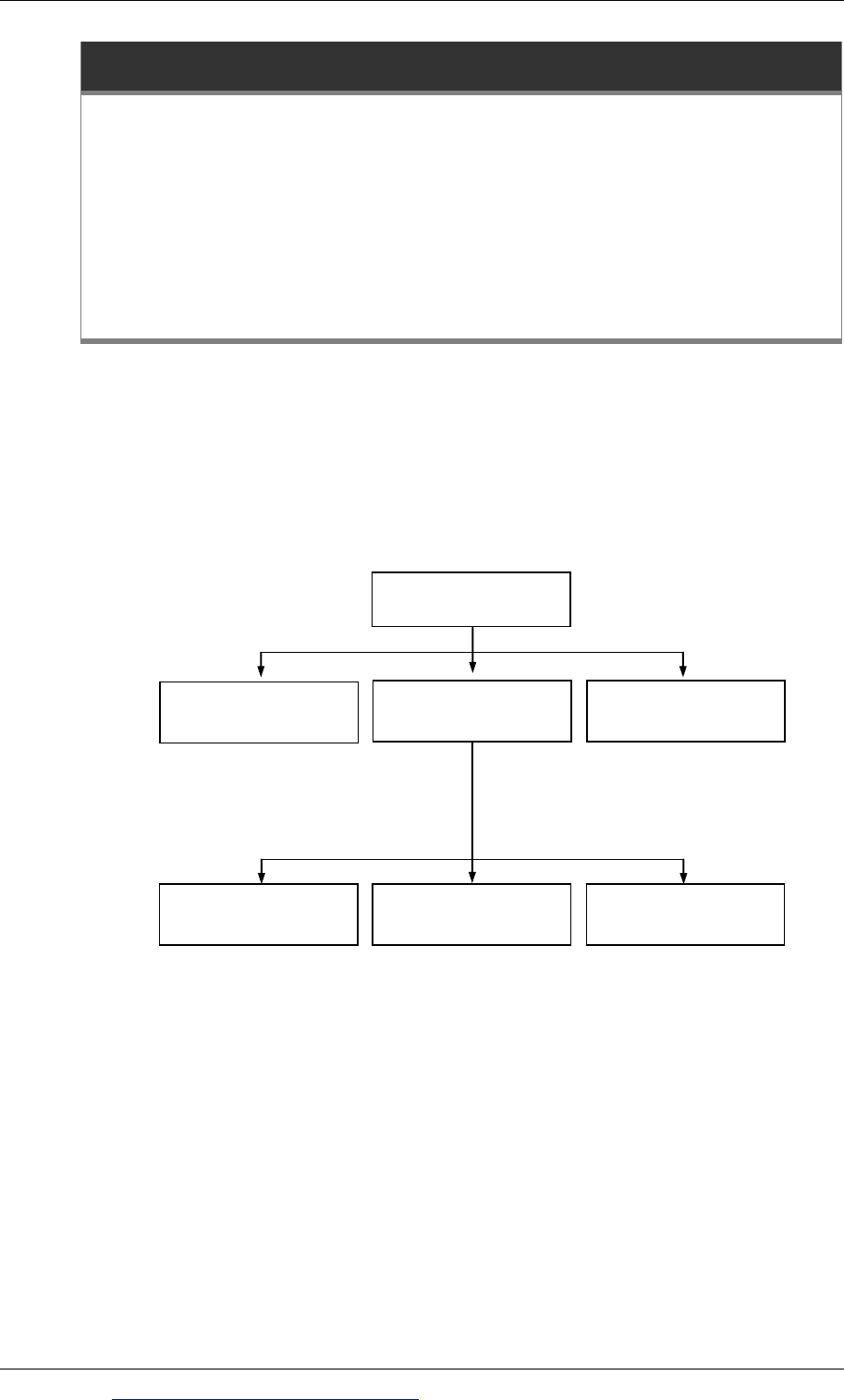ACCA P2 (INT) Corporate Reporting - Study text - 2010 (Emile Woolf)
Подождите немного. Документ загружается.


Chapter 19: Specialised entities
© EWP Go to www.emilewoolfpublishing.com for Q/As, Notes & Study Guides 493
ED 2009/8: Rate regulated activities
Background
Proposed guidance
3 ED 2009/8 Rate regulated activities
3.1 Background
Many governments have established regulatory mechanisms and bodies to govern
the provision of essential services such as electricity, gas etc. The regulatory
mechanisms often provide price protection to consumers whilst allowing companies
to earn a fair return.
Prices are often set in advance, based on estimated costs and volumes and a target
rate of return. The regulatory mechanism might also allow for the later
determination of actual costs and volumes. A company might then be allowed to
recover costs incurred through future rate increases. Alternatively, a company
might be required to return amounts to the consumer through future rate decreases.
This gives rise to gives rise to rights or obligations which may qualify as assets or
liabilities.
Illustration
X Plc is a regulated gas supplier. Flooding has caused significant damage to its
infrastructure. The regulatory mechanism allows X Plc to recover the costs of flood
damage costs from consumers over the five subsequent annual periods.
This right is clearly of benefit to X Plc. However it is unlikely that it would satisfy
the definition of an asset under existing IFRS.
In July 2009 the IASB issued an ED to address this issue. The ED contained
proposals to allow for assets and liabilities that arise from some rate-regulated
activities to be recognised under IFRS.
3.2 Proposed guidance
The ED clarifies in what circumstances regulated entities should recognise assets or
liabilities as a result of rate regulation, defines regulatory assets and regulatory
liabilities, sets out criteria for their recognition, specifies how they should be
measured and specifies disclosures.
The ED applies only to rate-regulated activities that meet the following two criteria:
an authorised body is empowered to establish rates that bind customers
the price established by regulation (the rate) is designed to recover the specific
costs the entity incurs in providing the regulated goods or services and to earn a
specified return (cost-of-service regulation).

Paper P2: Corporate Reporting (International)
494 Go to www.emilewoolfpublishing.com for Q/As, Notes & Study Guides © EWP
The ED requires an entity:
to recognise a regulatory asset or regulatory liability if the regulator permits the
entity to recover specific previously incurred costs or requires it to refund
previously collected amounts and to earn a specified return on its regulated
activities by adjusting the prices it charges its customers
to measure a regulatory asset or regulatory liability at the expected present value
of the cash flows to be recovered or refunded as a result of regulation, both on
initial recognition and at the end of each subsequent reporting period
to present current and non-current regulatory assets and regulatory liabilities,
without offsetting, separately from other assets and liabilities.

© EWP Go to www.emilewoolfpublishing.com for Q/As, Notes & Study Guides 495
Paper P2 (INT)
Corporate Reporting
CHAPTER
20
Performance measurement
Contents
1 Users of financial statements
2 Financial measures of performance
3 Financial ratios and examination technique

Paper P2: Corporate Reporting (International)
496 Go to www.emilewoolfpublishing.com for Q/As, Notes & Study Guides © EWP
Users of financial statements
Users and their information needs
Limitations of the financial statements
The information needs of management
Ratio analysis as a tool
1 Users of financial statements
1.1 Users and their information needs
The IASB Framework outlines seven different groups of users of financial
statements. Each user group has different information needs, but as a general rule
financial statements prepared in accordance with IFRSs should provide all user
groups with most of their needs.
The table below lists the user groups, indicates the information that they require
from published reports and accounts, and suggests which items in the financial
statements will be of most interest to each group.
User Information needs Items of interest
Investors/
potential
investors
Risks and returns relating to
their investment
Security of dividend
payments
Information to make
decisions about buying,
selling or holding shares
Future growth prospects.
Trend analysis: changes in
revenue, costs and profits
over the past few years
Dividend cover
Events and
announcements after the
reporting period
Share price
Corporate governance
reports. Narrative business
review.
Employees Stability of the company (job
security and job prospects)
Information about the
company’s ability to pay
bonuses or higher salaries.
Profitability and cash
position
Increases in salaries (%)
relative to increases in
profit and dividends
Directors’ remuneration
Lenders
(banks,
bondholders)
Whether the entity has
sufficient cash flow to repay
loans
The entity’s ability to pay
interest
The adequacy of collateral/
security for loans and bonds
Cash flow
Total borrowing by the
entity: financial gearing
Interest cover
New charges created over
the entity’s assets

Chapter 20: Performance measurement
© EWP Go to www.emilewoolfpublishing.com for Q/As, Notes & Study Guides 497
Suppliers The entity’s ability to settle
its liabilities
The entity’s ability to
survive and continue as a
customer
Net current assets
Growth record
Customers
The entity’s ability to
survive and continue as a
supplier
Growth record
Cash flow
Government The entity’s contribution to
the economy
Regulation of activities
Taxation
Obtaining government
statistics
Revenue and profit
Market share
General public Environmental and social
awareness
Contributions to the local
economy
Environmental and social
reports
Directors’ report
Narrative business review
Note
Management are not included as a user group because they should have access to
much more detailed information about the company’s financial position and
performance, from internal reports and budgets.
1.2 Limitations of the financial statements
The financial statements provide a starting point for understanding the entity’s
performance. However they have a number of limitations, which are explained
below.
Historical information
Published accounts are historical in nature, and report the past performance of the
company. Past performance does not guarantee future performance. However, there
is very little information in the audited financial statements about the future
prospects of the company.
A Chairman’s statement, a directors’ report and a business review or Operating and
Financial Review are produced by companies in some countries. These narrative
reports often include information about changes to the business and the outlook for
the next few years. However, these often provide insufficient information and can
not always be relied on to provide an ‘unbiased’ view of the company’s future
prospects.
Users of financial statements, particularly shareholders and other investors, may use
trend analysis to analyse a company’s performance over the past few years, and
predict future performance from past trends. Stock market announcements by a
company and press releases by the company to the media, together with general
economic information, can also be used to try to predict future performance.

Paper P2: Corporate Reporting (International)
498 Go to www.emilewoolfpublishing.com for Q/As, Notes & Study Guides © EWP
The effect of inflation
Inflation affects the information in financial statements prepared under the
historical cost convention. When the rate of inflation is fairly high, information in
the financial statements may be unreliable.
For many companies, many of the assets in the statement of financial position
are undervalued because in a period of fairly high inflation the replacement cost
of the assets will be substantially higher than their carrying values (at net book
value, based on historical cost).
IAS 16 and IAS 39 allow certain assets to be re-valued in the statement of
financial position whilst others are carried at historical cost.
In a period of inflation, the reported profit is also misleading when the historical
cost convention is applied. The reported profit does not take account of the higher
cost of replacing inventory that has been sold or non-current assets that have
reached the end of their useful life.
Access to information
Most users will not have access to the forecasts and projections produced by
management as part of their monthly management accounts. This information
would be invaluable to investors who want to assess the future prospects of the
company.
Some users of financial information may be in a position to ask a company to
provide this information. For example:
a bank will want to see the cash flow forecasts and business plans of a company
before agreeing to lend it money
the government may have a statutory right to demand detailed financial
information from a company, for example about its sales, in order to compile
national statistics.
Insufficient detail
IFRSs specify the disclosures of information that entities should provide in their
financial statements.
Much of the detailed information is aggregated into a total figure, and companies
generally provide only the minimum level of disclosure required by IFRSs. Some
international accounting standards require the disclosure of details, such as IFRS 5
Non-current assets held for sale and discontinued operations. These help with the
interpretation of performance, but the disclosures are still not given in sufficient
detail to satisfy the needs of all users.
Some standards include voluntary disclosure requirements. For example, IAS 7
recommends analysis of operating cash flows under the direct method. However,
most companies choose not to provide any more information than is absolutely
necessary, and most use the indirect method.

Chapter 20: Performance measurement
© EWP Go to www.emilewoolfpublishing.com for Q/As, Notes & Study Guides 499
Creative accounting
Over recent years, the rules in the IFRS accounting framework have been
strengthened, and the opportunities for ‘window dressing’ of the financial
statements have been reduced. Even so, there are still some opportunities for
companies to ‘manipulate’ the figures in their financial statements, to improve their
reported position and their financial ratios. This is known as creative accounting.
For example, some accounting standards still allow a choice of accounting
treatment. For example, IAS 16 allows the use of the cost model or revaluation
model for non-current assets. A company will be tempted to select the policy that
shows the ‘best’ results.
There are also a number of areas where accounting standards provide no rules or
where the rules on the accounting treatment of an item are unclear. This allows
companies to design their own accounting treatment, until such time as rules are
introduced or strengthened.
Even when standards do exist, the management of entities may be allowed to use
their judgement when applying an accounting policy or making an estimate. For
example, judgement is needed to decide whether the conditions have been met for
capitalisation of development costs (IAS 38).
Scope of the audit
In addition to the financial statements, the annual report and accounts published by
companies include other information that may be of relevance to users. This
information may include:
an operating and financial review, or a business review
a Chairman’s statement
a directors’ report
a corporate social responsibility report (or social and environmental report).
However, many companies publish an annual corporate social responsibility
report as a separate document.
The company itself is able to decide the content of these reports and the amount of
detail that they provide. As a general rule, a company will only want to publish
positive news and not the ‘bad news’. The information in these reports is not subject
to a full audit and so the audit opinion does not extend to them. (Auditors are
required to read the content of the reports, to ensure that it does not undermine the
credibility of the financial statements. If problems are found, the auditors will seek
adjustment from management but if this refused there is generally little that the
auditor can do.)
Note: In the EU, the recent EU accounts modernisation directive introduced a
requirement for listed companies to produce an annual business review. National
governments will give guidance or establish rules about what this review should
contain, but it will not be subject to audit.

Paper P2: Corporate Reporting (International)
500 Go to www.emilewoolfpublishing.com for Q/As, Notes & Study Guides © EWP
1.3 The information needs of management
The management of a company needs much more information about the financial
performance and position of their company than other user groups. They need
reports more regularly, and often they need access to information immediately
through on-line IT systems. They also need information in sufficient detail and
suitably analysed.
Management have access to this amount of information and detail through the
reporting systems of the company, and in budgets, forecasts, business plans,
strategy documents and monthly management accounts. Detailed reports on
inventory levels, slow-moving items and the ageing of outstanding receivables
should also be available from the management information systems of the company.
However, the quality of the management information is only as good as the system
that provides it. Poor management information (information that is inaccurate and
unreliable, provided too late or irrelevant) can lead to wrong decisions being made
by management.
The management of an entity may also have access to information about
competitors, such as market share statistics (if these are collected by industry
regulators or the government). The financial statements of competitors are also a
valuable source of information about their profit margins, sales growth and possible
weaknesses.
1.4 Ratio analysis as a tool
It is difficult to assess a company’s financial performance by analysing the financial
results for one year. Better information is obtained by making comparisons with
financial performance in the previous year, or perhaps over several periods (trend
analysis).
For example, if a company’s revenue has increased by 15%, it might be expected
that gross profit should also increase by at least 15%, and that receivables should
increase by 15%. To sustain the growth in operations, some increase in non-current
assets and inventory levels – perhaps a 15% increase – should also be expected.
Ratio analysis is a key tool used for performance analysis, because ratios summarise
financial information, often by relating two or more items to each other, and they
present financial information in a more understandable form. Ratios also identify
significant relationships between different figures in the financial statements.
For example, knowing that the profit of a company is $50,000 is not particularly
useful information on its own, because the expected amount of profit should be
dependent on the size of the business and the amount of its sales turnover. If the
company generated a profit of $50,000 from $150,000 of sales, then it has performed
well. However, if a profit of $50,000 has been made from sales of $5 million, then the
profit level is much weaker. The profit margin (the ratio of profit to sales) is a basic
and widely-used ratio for analysing the strength of a company’s financial
performance.

Chapter 20: Performance measurement
© EWP Go to www.emilewoolfpublishing.com for Q/As, Notes & Study Guides 501
A ratio on its own does not provide useful information. Ratios are useful because
they provide a basis for making comparisons. Comparisons might indicate that
performance or the financial position is better or worse than it should be, or is
getting better or worse than in the past.
For example, suppose that a company measures its profit margin in the current year
as 20%. Is this good or bad? To evaluate performance, the current year profit margin
of 20% should be interpreted, by comparing it with:
last year’s profit margin, or the company’s profit margin for the past few years
the budgeted profit margin (available to investors, perhaps, through company
announcements)
the industry average (the average profit margin for companies in the industry)
the profit margin reported by individual competitors.
For example, if the budgeted profit margin was 25%, an actual profit margin of 20%
might suggest that management have under-performed in the period.
Note that a ratio does not explain why any under-performance or out-performance
has occurred. Ratios are used to indicate areas of good or weak performance, but
management then have to investigate to identify the cause.
Example
A company achieved a profit margin of 6% in the year just ended. This was less than
the budgeted profit margin of 10%, and less than the profit margin in the previous
year, which was 8%.
The actual profit margin of 6% indicates disappointing performance, but
management should investigate the cause or causes. For example, they might find
that any of the following reasons might explain the low profit margin:
Increased competition has forced down sales prices and so reduced profit
margins.
Advances in technology have lowered costs but prices have come down even
more.
Raw material costs have risen and the higher costs could not be passed on to the
customers.
There have been higher employment costs due to pay rises for manufacturing
employees, but these could not be passed on to the customers.
The company buys most of its supplies from foreign countries, and adverse
movements in exchange rates for its purchases have increased costs and reduced
profit margins.
There has been a change in the company’s sales mix, and the company has sold a
larger proportion of cheaper and lower-margin products than expected.

Paper P2: Corporate Reporting (International)
502 Go to www.emilewoolfpublishing.com for Q/As, Notes & Study Guides © EWP
Financial measures of performance
Categories of financial ratios
Profitability ratios
Efficiency ratios
Short-term liquidity ratios
Long-term solvency ratios
Investor ratios
Limitations of financial ratios
2 Financial measures of performance
2.1 Categories of financial ratios
The basic financial ratios should already be familiar to you. Ratios can be divided
into five categories:
Financial position
ROCE
ROSF
Gross profit margin
Overheads %
Ratios
Profitability Efficiency
Inventory turnover
Receivables turnover
Payables period
Short-term liquidity
Long-term solvency
Investor ratios
Current ratio
Quick ratio
Gearing
Interest
EPS
PE
Dividend yield
Dividend cover
The main ratios will be considered in more detail. For the purpose of your
examination, you need to know how to calculate each ratio, but you must also
understand why each ratio, or each category of ratios, might be of particular interest
to a specific user group.
An examination question may ask you to provide an analysis of financial statements
for a particular user. It will not tell you which ratios to calculate. Instead, you will
have to decide for yourself which ratios may provide useful information for that
user. Therefore you should learn to identify and select the appropriate ratios for
each user group, and then analyse what the ratio appears to show, from the point of
view of that user.
